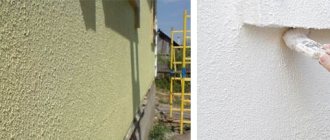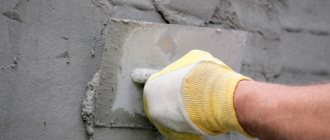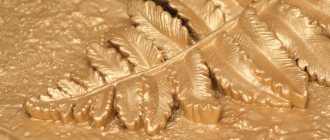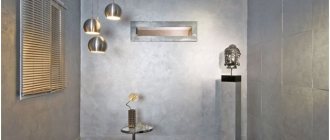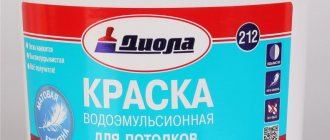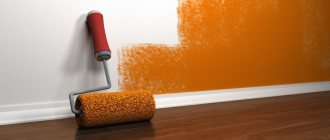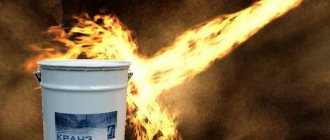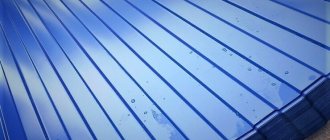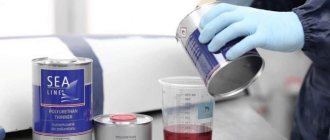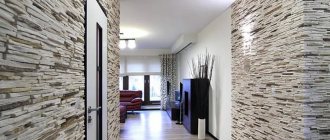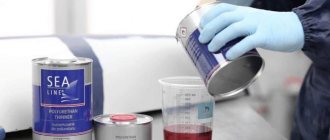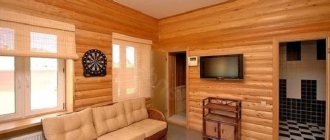Modern repair technologies help achieve original effects on various surfaces using a wide range of finishing materials. A popular finishing method is the use of textured paint in the interior. It is a liquid base to which various components, such as fillers and colors, are added as needed. In this article we will figure out how to apply textured wall paint with your own hands, its pros and cons.
Relief texture with different effects
There are many ways in which you can imitate the texture of natural materials, such as stone, leather or brick. In this article we will talk about the pros and cons of texture, properties and components, as well as the basic techniques for applying the composition.
Relief texture with different effects
Textured paints have become popular because they have a number of undeniable advantages:
- the coating hides minor wall defects and therefore does not require careful surface preparation;
- has high hardness (used as anti-vandal);
- water and weather resistant;
- vapor permeable - the walls will “breathe”;
- can be used on facades and for interior decoration.
Characteristics and composition of textured paint
The texture compositions of different brands differ in thickness. The paint itself has a high density and contains polymers and acrylic. To obtain a thick and elastic mixture, modified starch is used.
Manufacturers also add to the mixture:
- Quartz sand;
- Fine grain marble;
- Granite chips;
- Polymer fibers;
- Gas silicates.
In construction stores you can find a huge number of painting compounds from different manufacturers. They are suitable for both indoor and outdoor use. Some types can be used to finish the facade on top of the cladding.
The drying speed of the mixture is increased by acrylic polymer particles. During operation and subsequent drying, no unpleasant odor appears in the room.
Advantages of painting with a textured mixture
The advantages of textured paint are due to its composition - no solvents or acetone are used in production, which avoids the appearance of an unpleasant odor.
The main advantages of paint:
- Does not contain harmful and toxic components and impurities, so its use does not affect health in any way;
- Due to the fact that the mixture has a thick consistency, you can work with it even without gloves;
- Perfect alignment of the walls is not required - after applying the composition, small cracks and light defects will be hidden;
- Painting walls does not affect the microclimate in the room and does not impair air circulation;
- The coating can withstand high humidity, sudden temperature fluctuations, and is also resistant to the development of fungus;
- Modern manufacturers produce compositions that prevent fire and do not emit toxic substances when heated.
Recommendations for selection
Painting the walls is preceded by the purchase of a paint composition, and the purchase is preceded by a careful selection of its variety. Selecting paint for the walls in your apartment will be easier if you answer 5 questions:
- Which room of the house are you planning to renovate?
- What is the surface of the walls in the room (concrete, wood, plasterboard)?
- What is the condition of the walls now, is it necessary to mask small irregularities?
- What kind of coating (glossy, matte) and pattern do you want to get after application?
- Will the work be carried out in-house or by a professional craftsman?
The choice of textured paint is complicated by the fact that the packaging does not indicate what effect in wall decoration can be achieved with its help. Usually only the type of filler is indicated. For example, solutions with chalk, starch, and tiny crumbs are suitable for misuri.
In order not to make a mistake with the choice, to purchase exactly the color and effect that you need - ask the help of a consultant in a specialized store of finishing materials. It is best to show the seller a photo of the desired effect, so it will be easier to choose the composition.
Disadvantages of textured finishes
When choosing a paint with a plaster effect, you need to take into account the characteristics of the composition and how to work with it.
- The consumption of textured paint is higher than regular paint, so you need to correctly calculate the quantity and cost of the mixture.
- Dense layers dry in 5-6 hours at a temperature of about 25 degrees. While the coating is drying, it is strictly forbidden to open doors and windows to avoid peeling of the material.
- Before painting the damaged area, you need to dismantle the old coating and choose the right shade so that it does not differ from the previous one.
Despite some disadvantages, textured paint is a fairly popular finishing material. Beginners are captivated by the ease of working with it: you can paint walls without any experience. To complete the finishing you will not need any special tools or equipment.
The difference between texture paint and regular paint
Textured paint differs from simple paint in the composition and type of coating obtained.
Advantages
Colorants of this type have many advantages, the main one of which is versatility.
Texture paint creates a unique wall design.
Other positive qualities include:
- Moisture resistant. The material does not absorb liquids and does not contribute to the spread of unpleasant odors.
- Insensitivity to sunlight. The coating does not deform and does not fade.
- Wear resistance.
- Safety. The composition does not emit toxic fumes that have a poisonous effect on humans or animals.
- Resistant to temperature changes. The material does not ignite, which prevents the spread of fire in the event of a fire.
- Presence of antiseptic components. Using textured finishes prevents mold from growing indoors.
- Variety of colors and textures. The material creates a unique wall design.
Flaws
Thick layers require a lot of paint.
The negative characteristics of textured paint include the following:
- Price. Large expenses increase the financial costs of repairs.
- Difficult to apply. If repainting is necessary, the old coating is removed.
Characteristics and differences
Texture paint is a finely dispersed acrylic-based suspension. Used to decorate premises and building facades. The layer is resistant to mechanical damage and atmospheric factors. The paint is applied in an even layer to a properly prepared wall.
Structural paint dries completely after 2 hours.
The material has the following technical characteristics:
- solvent type – water;
- the basis of the coloring composition is acrylic;
- consumption – 1.5 kg/m²;
- storage conditions – in a closed container, at a temperature not higher than +5°C;
- Drying time – 2 hours.
The viscous consistency helps create different textures. The paint is applied with a spatula or roller.
Features of paint consistency
Unlike enamel and oil mixtures, textured paint has a thick consistency, due to which it is evenly distributed over the surface. To get a high-quality and durable coating, it is enough to apply the mixture in two layers.
The task of finishing with textured paint is to create a surface with an original design and an unusual, complex relief. Components such as fine sand and granite chips help give the coating an interesting texture.
Chip paint can be used for both exterior and interior work. With its help it is possible to imitate natural granite or marble. To apply such mixtures, use a stiff brush or small roller.
What it is?
So, what are texture paints?
This material creates or imitates a relief surface. Essentially, the technique of applying decorative paint lies somewhere between decorative plaster and ordinary paint (especially when it comes to creating texture). Differences from standard paint:
- Consistency. The decorative coating is thicker, somewhat reminiscent of very thick sour cream.
- Composition. In addition to the base and pigments, filler particles are used in production, which are responsible for volume.
- Large expense. The layer of textured dye can reach up to 15 mm, while the usual one is 2-3 mm.
Differences from decorative plaster:
- Application thickness. A thinner layer of paint is required.
- Consumption. Due to the reduction of the layer, the material consumption will naturally be less.
- Textured paints for interior decoration can create standard plaster effects (bark beetle, fur coat, lamb), or imitate marble, velvet, leather, silk, embossed paper.
In the photo there is “crumpled” volumetric paint
Types of compositions
For interior work, you can use a huge number of textured mixtures, which differ not only in color palette, but also in composition.
Among the most popular textured paints there are several types.
- Missouri. Manufacturers use acrylic fillers, as well as modified starch, to make this paint. With the help of such compositions it is possible to obtain a relief coating with a wave-like pattern, which is created with a special roller. Pigments can be added to the mixture to add a glossy shine to the finished coating. The peculiarity of this composition is that it can be carried even by hand.
- Marseille wax. The composition is based on wax and polymer fillers. This paint dries quickly, allowing you to create the effect of aged natural stone with a pattern that imitates natural stone when applied. A properly dried coating has a glossy shine. The paint can be used to decorate different rooms - imitation of natural stone can elevate any interior.
- Wet silk. This mixture uses cotton fibers and cellulose. The polymer base in combination with high-quality pigments allows you to obtain a rich color and pronounced texture. The finished coating resembles velvet or velor fabric: with it you can create an atmosphere of real luxury.
Methods for creating textured surfaces
The relief (texture) is created using fillers, tools, available materials and fingers.
The structure of the paint layer depends on the size and hardness of the filler particles. Textured paints use:
- granite or marble chips;
- crushed gas silicate - a hardened mixture of sand, lime, water;
- quartz sand;
- wood sawdust;
- metallic sparkles;
- nacre;
- silk, cotton fibers;
- modified starch.
Large solid particles give a bumpy surface, small ones give a rough surface. Soft fillers make the paint thicker. If you make grooves in it during application, they will not blur.
To create a texture, the following tools are used:
- applicators;
- flat and notched spatulas;
- graters;
- trowels;
- brushes;
- brushes;
- textured rollers.
To create texture, improvised means are also used. Take a sponge or a crumpled plastic bag and apply it to a freshly painted wall. Traces remain on the surface - chaotic, and therefore original.
Preparing walls for application
To carry out the finishing, it is absolutely not necessary to invite specialists: even a novice in painting can handle the work. Finishing putty is not needed, and small external defects in the walls can be corrected using a building mixture - it can be applied to an untreated surface.
Before application, the walls are cleaned of dirt and dust. To ensure that the paint is distributed evenly, it is best to clean the surface with a soap solution. Using a primer improves the adhesion of the material to the concrete surface.
Necessary tool
Decorating surfaces requires a certain skill. In addition to traditional painting tools, you can experiment with texture using available materials :
- crumpled foil;
- a twisted piece of rough fabric;
- coarse sponge;
- a bunch of plastic bags;
- fur attachment for the roller;
- coarse sandpaper;
- stencil or relief print;
- comb (wooden or rubber scraper, notched trowel);
- silicone or plastic mold for decorating the “stone”.
Before you start painting walls with a textured composition, prepare protective clothing and safety glasses. The room must be vacuumed, since abrasive particles from grinding reduce adhesion.
It is recommended to work using the tool indicated on the packaging of the decorative mixture. Otherwise, the standard set includes:
- spatula and trowel;
- roller with structural attachments;
- container for solution;
- construction mixer (drill with kneading attachment);
- a ditch for collecting paint with a roller.
To apply liquid compounds, it is suggested to use a paint spray gun. It will quickly and evenly distribute the texture dye over the surface of walls or ceilings.
Crinkled foil Roller with fur attachment
Comb Spatula
Roller with a structured attachment
Paint cuvette Please note: What is zinc paint used for?
Working with textured paint
Painting the walls is done in stages.
- First of all, the mixture needs to be stirred for several minutes, adding a color that is sold in special hardware stores. You can also purchase a ready-made composition. By adding pigment yourself, you can control the intensity of the shade.
- The composition is applied to the walls using a construction spatula.
- An original pattern is created with a special roller.
- Each layer is allowed to dry for an hour.
If necessary, after the layers have completely dried, additional protective wax is applied to extend the service life of the coating.
